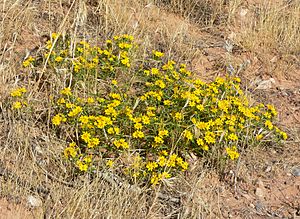Cinchweed facts for kids
Quick facts for kids Cinchweed |
|
|---|---|
 |
|
| var. papposa | |
| Conservation status | |
| Scientific classification | |
| Kingdom: | |
| (unranked): | |
| (unranked): | |
| (unranked): | |
| Order: | |
| Family: | |
| Genus: |
Pectis
|
| Species: |
P. papposa
|
| Binomial name | |
| Pectis papposa |
|
Pectis papposa is a type of flowering plant in the Asteraceae family, which is also known as the aster or daisy family. This plant is native to North America. You can find it growing in the southwestern United States, reaching as far east as Texas, and also in northern Mexico. Some common names for this plant include cinchweed, common chinchweed, many-bristle chinchweed, and many-bristle fetid-marigold. It's also a special plant because it acts as a host for the beet leafhopper, meaning the leafhopper uses it for food and shelter.
What is Cinchweed Used For?
Pectis papposa is quite useful! In Mexican markets, people often sell it under the name limoncillo. It is used in small amounts to add flavor to meat dishes.
How Do Native American Peoples Use Cinchweed?
Many different indigenous peoples have found ways to use Pectis papposa for centuries.
- The Seri have several names for the plant, including casol and casol heecto (which means "small casol"). They also call it casol ihasii tiipe ("fragrant casol") and cacatajc ("what causes vomiting"). The Seri people use this plant for traditional medicine.
- The Pima use a special liquid made from the plant, called a decoction, or the dried plant itself. They use it as a laxative, which helps with digestion and keeps the body regular.
- The Zuni people make a drink from the whole plant. They use this drink to help with an upset stomach or gas. They also use a liquid made from the flowers as eye drops for snowblindness, which is when your eyes hurt from too much bright light. Before dancing in special ceremonies, they chew the flowers to use them as perfume.
- The Havasupai people prepare the seeds by heating and grinding them. They then use these ground seeds to make mush and soup. They also dip the fresh plant in salt water and eat it with mush or cornmeal as a tasty side dish.
- The Pueblo use Pectis papposa as a spice in their cooking.


